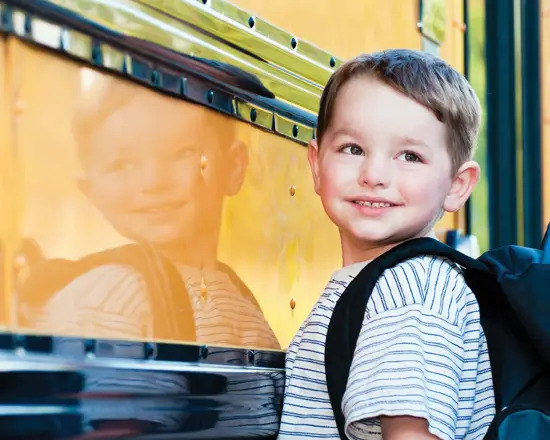Riding the school bus, for kids with autism or sensory issues, can be an overwhelming and uncomfortable experience. A local expert explains how parents can help make the ride more manageable.
 For kids on the autism spectrum, riding the bus to school can be an overwhelming sensory experience that causes anxiety and agitation. Fortunately, there are several ways parents can prepare their child for this experience and make the trip to school more manageable from the start of the year.
For kids on the autism spectrum, riding the bus to school can be an overwhelming sensory experience that causes anxiety and agitation. Fortunately, there are several ways parents can prepare their child for this experience and make the trip to school more manageable from the start of the year.
Debra Reicher, Ph.D., the director of psychological services at The Hagedorn Little Village School in Seaford, offers advice on how to make the bus ride more comfortable.
What are some things parents can do to make the school bus ride more comfortable for their children with autism?
Children on the autism spectrum vary in their overall levels of functioning. However, the core deficits in all ASD children are related to social communication. Many children with ASD also have sensory issues and may find certain sensory stimuli such as noise, smells, and lights overwhelming. Riding on a school bus can place some children with ASD on sensory overload, which can result in anxiety and agitation. Providing ways for your child to remain calm and self sooth while riding on the bus can be helpful. This may include giving your child a small and safe toy to hold and/or play with while riding the bus or a comfort object from home such as a stuffed animal. Some children with autism have difficulty relinquishing certain items and s/he may find it comforting to hold these preferred items when stressed. For children who find noisy areas stressful, headphones or an iPod may help if approved by the bus company.
Many children with ASD have difficulty tolerating change or new situations. For children who have not had experience riding the bus, preparing them for this experience ahead of time can be helpful. Many children with ASD are visual learners. Preparing a detailed story about riding the bus with words and pictures can help the child anticipate what to expect. You can even take real photographs of the bus, the bus driver, and the school to help the child with this experience. The child can also take a visual schedule that can be affixed to a laminated strip on the bus which breaks down the steps in detail and with pictures (i.e. I get on the bus, I put my seatbelt on, I stay seated, I get off the bus when I get to my school).
Who in the school system can help parents address problems their child may be having on the bus?
Parents should contact the bus company as well as the child’s teacher and, if necessary, the school psychologist. Enhancing the communication between the bus staff, parent, and school is the best way to ensure an easy bus trip for the child. Parents should provide the bus driver with information about their child, for example, how s/he communicates, what s/he likes, and what may overwhelm him or her. Investigating the cause of the problem must be a team effort and precipitants such as sensory stimuli (i.e. noise), the length of the bus ride, and the impact of other children must all be considered.
Would you recommend parents introduce their child to the other kids on the bus before school starts?
This may not necessarily help since children on the autism spectrum have difficulties with developing peer relationships. As many ASD children are in mainstream schools, educating typically developing children about autism is likely to increase the compassion and empathy of other children and ultimately decrease problems on the bus.
Debra Reicher, Ph.D., is the director of psychological services at The Hagedorn Little Village School on Long Island, a nonprofit school that provides educational and therapeutic services to children with developmental disabilities. Dr. Reicher has been performing diagnostic evaluations and working with children and families with autism spectrum disorders for more than 20 years.
Also See:
Why Children on the Autism Spectrum are More Vulnerable to Bullying
Autism Speaks Launches School Community Tool Kit 2.0





















